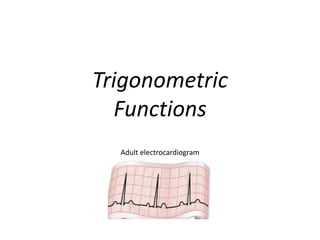
Trigonometric functions
- 2. Trigonometric Functions: Periodic functions are functions that repeat exactly in regular intervals called cycles . The length of the cycle is called its period .
- 3. The amplitude of sine and cosine functions is half of the difference between the maximum and minimum values of the function. The amplitude is always positive. Characteristics of the Graphs of Sine and Cosine
- 4. You can use the parent functions to graph transformations y = a sin bx and y = a cos bx. • Recall that a indicates a vertical stretch (⎪a⎥ > 1) or compression (0 < ⎪a⎥ < 1) , which changes the amplitude. • If a is less than 0, the graph is reflected across the x-axis. • The value of b indicates a horizontal stretch or compression, which changes the period. Transformations of Sine and Cosine Graphs Example: Using f (x) = sin x as a guide, graph the function g(x) = 3 sin 2x. Identify the amplitude and period.
- 5. Frequency is the number of cycles in a given unit of time, so it is the reciprocal of the period of a function. Frequency Example: Sine and cosine can also be translated as y = sin (x - h) + k and y = cos (x - h) + k. Recall that a vertical translation by k units moves the graph up (k > 0) or down (k < 0) . • A phase shift is a horizontal translation of a periodic function. A phase shift of h units moves the graph left (h < 0) or right (h > 0) . Phase shift
- 6. Using f (x) = sin x as a guide, graph g(x) = sin (x + π /2 ) . Identify the x-intercepts and phase shift. Example: You can combine the transformations of trigonometric functions. Use the values of a, b, h, and k to identify the important features of a sine or cosine function. Note:
